| Article ID | Journal | Published Year | Pages | File Type |
|---|---|---|---|---|
| 7233677 | Biosensors and Bioelectronics | 2014 | 8 Pages |
Abstract
A low potential and competitive photoelectrochemical biosensing platform was developed using quantum dots sensitized titanium dioxide decorated reduced graphene oxide (TiO2-RGO) nanocomposites. The nanocomposites were prepared through electrostatic interaction between mercaptoacetic acid wrapped CdSe quantum dots with negative charge and TiO2-RGO hybrids with positive charge obtained via ultrasonic and acid treatments. Electron microscopes and spectroscopes were used to characterize the functionalized nanocomposites films of CdSe/TiO2-RGO, and the fabrication process of the photoelectrochemical biosensor. Based on the high photovoltaic conversion efficiency of CdSe/TiO2-RGO nanocomposites films, after introducing biological recognition and competitive immunoreaction, a low potential and competitive photoelectrochemical biosensor for carcinoembryonic antigen (CEA) detection was fabricated. The synergic effect of horseradish peroxide and benzo-4-chlorohexadienone decreased the background signal, leading to signal amplification. Under the light irradiation of 430 nm and the applied potential of 0 V, the biosensor detected CEA with a linear range from 0.003 to 100 ng mLâ1 and the detection limit was estimated to be 1.38 pg mLâ1 at a S/N of 3. It was satisfactory for clinical sample detection. The proposed competitive and low potential photoelectrochemical biosensor under irradiation of visible light exhibited good performance, which has a promising prospect in clinical diagnose.
Related Topics
Physical Sciences and Engineering
Chemistry
Analytical Chemistry
Authors
Xianxiang Zeng, Jianchun Bao, Min Han, Wenwen Tu, Zhihui Dai,
